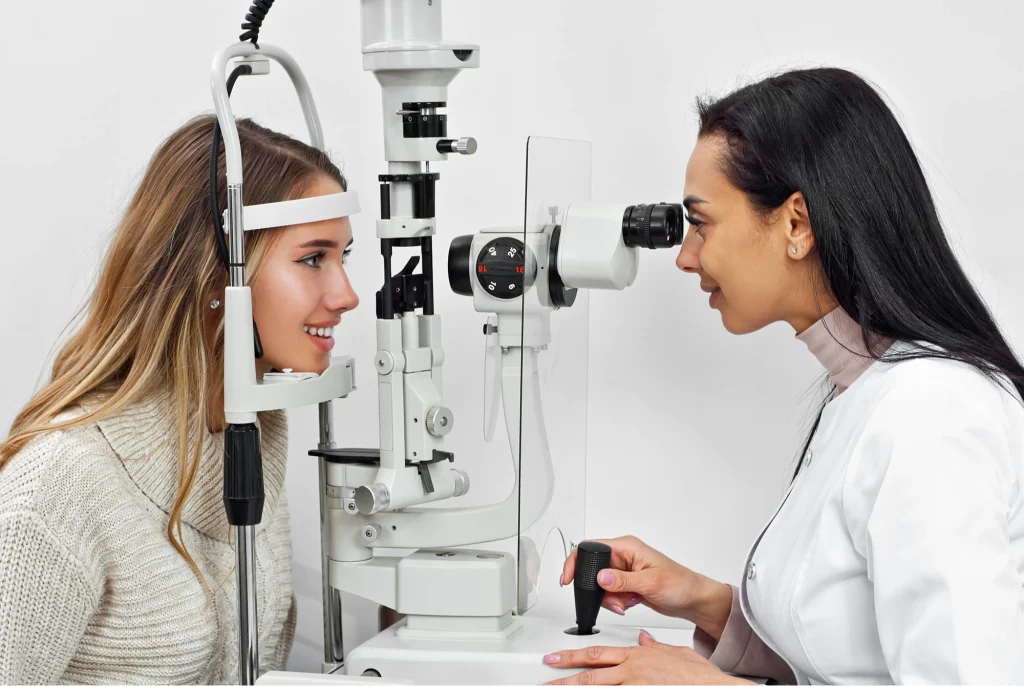Medically Reviewed by: Nicholas P. Bell, M.D.
Know Your Type of Glaucoma
There are several types of glaucoma. The two main types are open-angle and angle-closure. These are marked by an increase of intraocular pressure (IOP), or pressure inside the eye.
Open-Angle Glaucoma:
This is the most common form of glaucoma, affecting about three million Americans. It happens when the eye’s drainage canals become clogged over time.
The inner eye pressure (also called intraocular pressure or IOP) rises because the correct amount of fluid can’t drain out of the eye. With open-angle glaucoma, the entrances to the drainage canals are clear and should be working correctly. The clogging problem occurs further inside the drainage canals, similar to a clogged pipe below the drain in a sink.
Most people have no symptoms and no early warning signs. If open-angle glaucoma is not diagnosed and treated, it can cause a gradual loss of vision. This type of glaucoma develops slowly and sometimes without noticeable sight loss for many years. It usually responds well to medication, especially if caught early and treated.
Angle-Closure Glaucoma:
This type of glaucoma is also known as acute glaucoma or narrow angle glaucoma. It is much more rare and is very different from open-angle glaucoma in that the eye pressure usually rises very quickly.
This happens when the drainage canals get blocked or covered over, like a sink with something covering the drain.
With angle-closure glaucoma, the iris is not as wide and open as it should be. The outer edge of the iris bunches up over the drainage canals, when the pupil enlarges too much or too quickly. This can happen when entering a dark room.
A simple test can be used to see if your angle is normal and wide or abnormal and narrow.
Symptoms of angle-closure glaucoma may include headaches, eye pain, nausea, rainbows around lights at night, and very blurred vision.
Normal-Tension Glaucoma:
Also called low-tension or normal-pressure glaucoma, in normal-tension glaucoma the optic nerve is damaged even though the pressure in the eye is not very high. Doctors do not know why some people’s optic nerves are damaged even though they have almost normal pressure levels.
Those at higher risk for this form of glaucoma are:
- People with a family history of normal-tension glaucoma
- People of Japanese ancestry
- People with a history of systemic heart disease such as irregular heart rhythm.
Early detection, through regular and complete eye exams, is the key to protecting your vision.
Related Articles
Financing Options Available
Apply today to find a financing option that meets your needs.
Our Locations
Houston/Bellaire
6565 W. Loop S., Suite 650Bellaire, TX 77401
Medical Office:
713-797-1010
Medical Fax:
713-357-7276
LASIK/Near Vision:
Office: 713-395-1515
Fax: 713-357-7278
Pasadena
4415 Crenshaw RoadPasadena, TX 77504
Medical Office:
281-977-8800
Medical Fax:
281-977-8877
Sugar Land
15200 S.W. Freeway, Suite 130Sugar Land, TX 77478
Medical Office:
281-277-1010
Medical Fax:
281-277-4504
Clear Lake
455 E. Medical Center Blvd., Suite 110Webster, TX 77598
Medical Office:
281-332-1397
Medical Fax:
281-282-9152
Katy
Greenhouse Medical Plaza2051 Greenhouse Road, Suite 110
Houston, TX 77084
Medical Office:
346-547-7070
Medical Fax:
281-214-2971
The Woodlands/Conroe
100 Medical Center Blvd., Suite 118Conroe, TX 77304
Medical Office:
936-647-1610
Medical Fax:
936-647-1620


